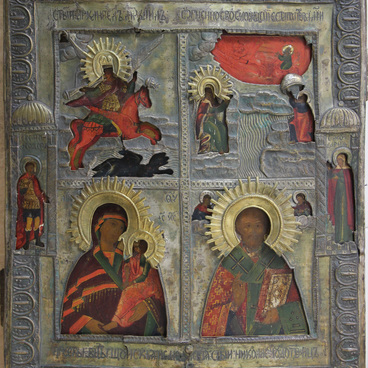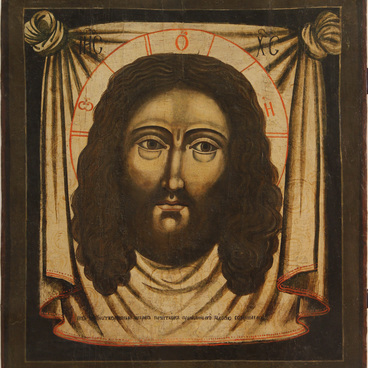Elijah the Prophet in the Desert
Время создания
Late 18th century
Размер
107x90,8 cm
107х90.8х3.8 cm
107х90.8х3.8 cm
Техника
Wood, tempera
Выставка
#1

Unknown author
Elijah the Prophet in the Desert
#3
#2
Elijah the Prophet is one of the Old Testament Prophets. He lived and preached 9 centuries before the birth of Jesus Christ. In those times Israel was ruled by King Ahab and the Phoenician pagan Queen Jezebel. At the court, she established a whole pool of priests who performed sacrifices to pagan gods. Elijah hampered one of those rituals and killed the priests; then he fled, being afraid of punishment. After 40 days of wandering through the desert he reached Mount Horeb and settled in one of the caves. There, an angel arrived to him and revealed him his mission: Elijah was supposed to return to Jerusalem, adopt a disciple and resume his preaching. Risking his life, the Prophet came back to Ahab’s land and together with his disciple Elisha was telling the pagans about the one god. According to the legend, in his declining years Elijah ascended to heaven in a fiery chariot drawn by winged horses.
#4
Elijah the Prophet has been worshiped in Russia since the old days; even one of the first Orthodox cathedrals in Kiev was consecrated in his name. The Saint was especially much worshipped in the Russian North, as fire is a symbol of purification for Old Believers. It is there, in the Russian North, where the iconography of Elijah the Prophet originated. The most frequent subject was the fiery ascension with hagiography, however, there were also other versions.
Elijah’s holy face was also a frequent subject for icons in the Volga region, where there also were villages of Old Believers. Icon workshops first appeared there in the 17th century, their icons had traits of the Moscow and Stroganoff Schools. Painters used to choose complex subjects, their paintings became more ornate and their palette was more colorful. It was exactly in the Volga Region where the icon from the collection of the State Museum of Fine Arts of Khanty-Mansiysk.
#5
The icon
#6
Per old tradition, the major subjects from the life of Elijah the Prophet were depicted in the icon: Elijah hiding in the cave (this is the central image), appearing of the angel, Elijah and his disciple separating the waters of the Jordan, Elijah giving his disciple his cape and gifts and then ascending to heaven in a fiery chariot. In the left-hand side of the icon a new subject appeared: Elijah lighting the fire of sacrifice.
#7
The icon is painted on wood. With this purpose the painter used a solid board cut out of the heartwood, where the wood is less distorted by drying. The base was coated with the primer consisted of chalk, glue and oil. The main image was painted with tempera, i.e. with the paint made of powdered pigments dissolved in raw egg yolks.
#8
State Museum of Fine Arts of Khanty-Mansiysk
читать дальшескрыть
00:00
00:00
1x
Elijah the Prophet in the Desert
Время создания
Late 18th century
Размер
107x90,8 cm
107х90.8х3.8 cm
107х90.8х3.8 cm
Техника
Wood, tempera
Выставка
Открыть в приложении
Поделиться

